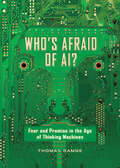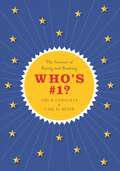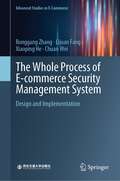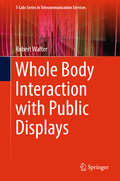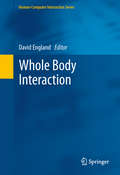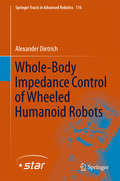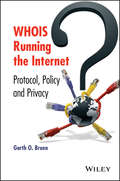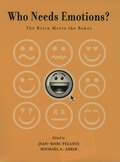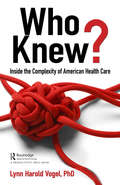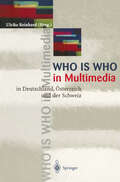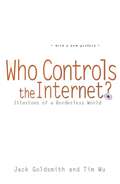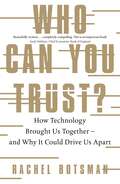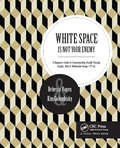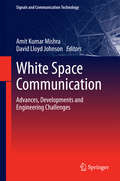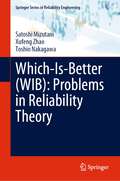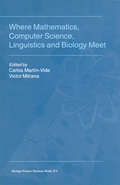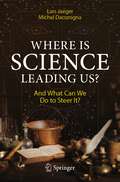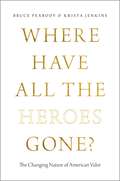- Table View
- List View
Who's Afraid of AI?: Fear and Promise in the Age of Thinking Machines
by Thomas RamgeA penetrating guide to artificial intelligence: what it is, what it does, and how it will change our lives At a breathtaking pace, artificial intelligence is getting better and faster at making complex decisions. AI can already identify malignant tumors on CT scans, give legal advice, out-bluff the best poker players in the world, and, with ever-increasing skill, drive our cars. In Who&’s Afraid of AI?, award-winning author Thomas Ramge expertly explains how machines are learning to learn, and he questions what today&’s explosion of AI capability could mean for tomorrow: Is it ethical to allow robots—endlessly patient—to replace human caregivers in providing comfort and companionship to the elderly?Since AI feeds on big data, can we prevent its misuse by corporations or the government?Will AI ever be capable of runaway self-improvement? And if &“the singularity&” does arrive, with AI&’s intelligence exponentially outpacing our own, what will become of us when, in many ways, we&’re obsolete?
Who's #1?: The Science of Rating and Ranking
by Amy N. Langville Carl D. MeyerA website's ranking on Google can spell the difference between success and failure for a new business. NCAA football ratings determine which schools get to play for the big money in postseason bowl games. Product ratings influence everything from the clothes we wear to the movies we select on Netflix. Ratings and rankings are everywhere, but how exactly do they work? Who's #1? offers an engaging and accessible account of how scientific rating and ranking methods are created and applied to a variety of uses. Amy Langville and Carl Meyer provide the first comprehensive overview of the mathematical algorithms and methods used to rate and rank sports teams, political candidates, products, Web pages, and more. In a series of interesting asides, Langville and Meyer provide fascinating insights into the ingenious contributions of many of the field's pioneers. They survey and compare the different methods employed today, showing why their strengths and weaknesses depend on the underlying goal, and explaining why and when a given method should be considered. Langville and Meyer also describe what can and can't be expected from the most widely used systems. The science of rating and ranking touches virtually every facet of our lives, and now you don't need to be an expert to understand how it really works. Who's #1? is the definitive introduction to the subject. It features easy-to-understand examples and interesting trivia and historical facts, and much of the required mathematics is included.
Who's #1?: The Science of Rating and Ranking
by Amy N. Langville Carl D. MeyerA website's ranking on Google can spell the difference between success and failure for a new business. NCAA football ratings determine which schools get to play for the big money in postseason bowl games. Product ratings influence everything from the clothes we wear to the movies we select on Netflix. Ratings and rankings are everywhere, but how exactly do they work? Who's #1? offers an engaging and accessible account of how scientific rating and ranking methods are created and applied to a variety of uses. Amy Langville and Carl Meyer provide the first comprehensive overview of the mathematical algorithms and methods used to rate and rank sports teams, political candidates, products, Web pages, and more. In a series of interesting asides, Langville and Meyer provide fascinating insights into the ingenious contributions of many of the field's pioneers. They survey and compare the different methods employed today, showing why their strengths and weaknesses depend on the underlying goal, and explaining why and when a given method should be considered. Langville and Meyer also describe what can and can't be expected from the most widely used systems. The science of rating and ranking touches virtually every facet of our lives, and now you don't need to be an expert to understand how it really works. Who's #1? is the definitive introduction to the subject. It features easy-to-understand examples and interesting trivia and historical facts, and much of the required mathematics is included.
The Whole Process of E-commerce Security Management System: Design and Implementation (Advanced Studies in E-Commerce)
by Ronggang Zhang Lijuan Fang Xiaoping He Chuan WeiThis book systematically and integrally introduces the new security management theories and methods in the e-commerce environment. Based on the perspective of dynamic governance of the whole process, starting from the theoretical framework, this book analyzes the gap between the current situation and requirements of security management, defines its nature, function, object and system, and designs and constructs the whole process security management organization and operation system of e-commerce. It focuses on the core and most prominent risk control links (i.e. security impact factors) in e-commerce security, including e-commerce information and network security risk, e-commerce transaction risk, e-commerce credit risk, e-commerce personnel risk, etc. Then, the tools and methods for identifying and controlling various risks are described in detail, at the same time, management decision-making and coordination are integrated into the risk management. Finally, a closed loop of self-optimization is established by a continuous optimization evolution path of e-commerce security management.
Whole Body Interaction with Public Displays (T-Labs Series in Telecommunication Services)
by Robert WalterThis book develops valuable new approaches to digital out-of-home media and digital signage in urban environments. It offers solutions for communicating interactive features of digital signage to passers-by. Digital out-of-home media and digital signage screens are becoming increasingly interactive thanks to touch input technology and gesture recognition. To optimize their conversion rate, interactive public displays must 1) attract attention, 2) communicate to passers-by that they are interactive, 3) explain the interaction, and 4) provide a motivation for passers-by to interact.This book highlights solutions to problems 2 and 3 above. The focus is on whole-body interaction, where the positions and orientations of users and their individual body parts are captured by specialized sensors (e.g., depth cameras). The book presents revealing findings from a field study on communicating interactivity, a laboratory on analysing visual attention, a field study on mid-air gestures, and a field study on using mid-air gestures to select items on interactive public displays.
Whole Body Interaction (Human–Computer Interaction Series)
by David EnglandWhole Body Interaction is “The integrated capture and processing of human signals from physical, physiological, cognitive and emotional sources to generate feedback to those sources for interaction in a digital environment” (England 2009).Whole Body Interaction looks at the challenges of Whole Body Interaction from the perspectives of design, engineering and research methods. How do we take physical motion, cognition, physiology, emotion and social context to push boundaries of Human Computer Interaction to involve the complete set of human capabilities? Through the use of various applications the authors attempt to answer this question and set a research agenda for future work.Aimed at students and researchers who are looking for new project ideas or to extend their existing work with new dimensions of interaction.
Whole-Body Impedance Control of Wheeled Humanoid Robots (Springer Tracts in Advanced Robotics #116)
by Alexander DietrichIntroducing mobile humanoid robots into human environments requires the systems to physically interact and execute multiple concurrent tasks. The monograph at hand presents a whole-body torque controller for dexterous and safe robotic manipulation. This control approach enables a mobile humanoid robot to simultaneously meet several control objectives with different pre-defined levels of priority, while providing the skills for compliant physical contacts with humans and the environment. After a general introduction into the topic of whole-body control, several essential reactive tasks are developed to extend the repertoire of robotic control objectives. Additionally, the classical Cartesian impedance is extended to the case of mobile robots. All of these tasks are then combined and integrated into an overall, priority-based control law. Besides the experimental validation of the approach, the formal proof of asymptotic stability for this hierarchical controller is presented. By interconnecting the whole-body controller with an artificial intelligence, the immense potential of the integrated approach for complex real-world applications is shown. Several typical household chores, such as autonomously wiping a window or sweeping the floor with a broom, are successfully performed on the mobile humanoid robot Rollin’ Justin of the German Aerospace Center (DLR). The results suggest the presented controller for a large variety of fields of application such as service robotics, human-robot cooperation in industry, telepresence in medical applications, space robotics scenarios, and the operation of mobile robots in dangerous and hazardous environments.
WHOIS Running the Internet: Protocol, Policy, and Privacy
by Garth O. BruenDiscusses the evolution of WHOIS and how policy changes will affect WHOIS’ place in IT today and in the futureThis book provides a comprehensive overview of WHOIS. The text begins with an introduction to WHOIS and an in-depth coverage of its forty-year history. Afterwards it examines how to use WHOIS and how WHOIS fits in the overall structure of the Domain Name System (DNS). Other technical topics covered include WHOIS query code and WHOIS server details. The book also discusses current policy developments and implementations, reviews critical policy documents, and explains how they will affect the future of the Internet and WHOIS. Additional resources and content updates will be provided through a supplementary website. Includes an appendix with information on current and authoritative WHOIS services around the world Provides illustrations of actual WHOIS records and screenshots of web-based WHOIS query interfaces with instructions for navigating them Explains network dependencies and processes related to WHOIS utilizing flowcharts Contains advanced coding for programmers Visit the book's companion website http://whois.knujon.com for technical and policy documents concerning WHOIS, WHOIS code examples, internet locations for WHOIS databases and more. WHOIS Running the Internet: Protocol, Policy, and Privacy is written primarily for internet developers, policy developers, industry professionals in law enforcement, digital forensic investigators, and intellectual property attorneys.Garth O. Bruen is an Internet policy and security researcher whose work has been published in the Wall Street Journal and the Washington Post. Since 2012 Garth Bruen has served as the North American At-Large Chair to the Internet Corporation of Assigned Names and Numbers (ICANN). In 2003 Bruen created KnujOn.com with his late father, Dr. Robert Bruen, to process and investigate Internet abuse complaints (SPAM) from consumers. Bruen has trained and advised law enforcement at the federal and local levels on malicious use of the Domain Name System in the way it relates to the WHOIS record system. He has presented multiple times to the High Technology Crime Investigation Association (HTCIA) as well as other cybercrime venues including the Anti-Phishing Working Group (APWG) and the National Center for Justice and the Rule of Law at The University of Mississippi School of Law. Bruen also teaches the Fisher College Criminal Justice School in Boston where he develops new approaches to digital crime.
WHOIS Running the Internet: Protocol, Policy, and Privacy
by Garth O. BruenDiscusses the evolution of WHOIS and how policy changes will affect WHOIS’ place in IT today and in the futureThis book provides a comprehensive overview of WHOIS. The text begins with an introduction to WHOIS and an in-depth coverage of its forty-year history. Afterwards it examines how to use WHOIS and how WHOIS fits in the overall structure of the Domain Name System (DNS). Other technical topics covered include WHOIS query code and WHOIS server details. The book also discusses current policy developments and implementations, reviews critical policy documents, and explains how they will affect the future of the Internet and WHOIS. Additional resources and content updates will be provided through a supplementary website. Includes an appendix with information on current and authoritative WHOIS services around the world Provides illustrations of actual WHOIS records and screenshots of web-based WHOIS query interfaces with instructions for navigating them Explains network dependencies and processes related to WHOIS utilizing flowcharts Contains advanced coding for programmers Visit the book's companion website http://whois.knujon.com for technical and policy documents concerning WHOIS, WHOIS code examples, internet locations for WHOIS databases and more. WHOIS Running the Internet: Protocol, Policy, and Privacy is written primarily for internet developers, policy developers, industry professionals in law enforcement, digital forensic investigators, and intellectual property attorneys.Garth O. Bruen is an Internet policy and security researcher whose work has been published in the Wall Street Journal and the Washington Post. Since 2012 Garth Bruen has served as the North American At-Large Chair to the Internet Corporation of Assigned Names and Numbers (ICANN). In 2003 Bruen created KnujOn.com with his late father, Dr. Robert Bruen, to process and investigate Internet abuse complaints (SPAM) from consumers. Bruen has trained and advised law enforcement at the federal and local levels on malicious use of the Domain Name System in the way it relates to the WHOIS record system. He has presented multiple times to the High Technology Crime Investigation Association (HTCIA) as well as other cybercrime venues including the Anti-Phishing Working Group (APWG) and the National Center for Justice and the Rule of Law at The University of Mississippi School of Law. Bruen also teaches the Fisher College Criminal Justice School in Boston where he develops new approaches to digital crime.
Who Needs Emotions?: The Brain Meets the Robot (Series in Affective Science)
by Jean-Marc Fellous Michael A. ArbibThe idea that some day robots may have emotions has captured the imagination of many and has been dramatized by robots and androids in such famous movies as 2001 Space Odyssey's HAL or Star Trek's Data. By contrast, the editors of this book have assembled a panel of experts in neuroscience and artificial intelligence who have dared to tackle the issue of whether robots can have emotions from a purely scientific point of view. The study of the brain now usefully informs study of the social, communicative, adaptive, regulatory, and experimental aspects of emotion and offers support for the idea that we exploit our own psychological responses in order to feel others' emotions. The contributors show the many ways in which the brain can be analyzed to shed light on emotions. Fear, reward, and punishment provide structuring concepts for a number of investigations. Neurochemistry reveals the ways in which different "neuromodulators" such as serotonin, dopamine, and opioids can affect the emotional valence of the brain. And studies of different regions such as the amygdala and orbitofrontal cortex provide a view of the brain as a network of interacting subsystems. Related studies in artificial intelligence and robotics are discussed and new multi-level architectures are proposed that make it possible for emotions to be implemented. It is now an accepted task in robotics to build robots that perceive human expressions of emotion and can "express" simulated emotions to ease interactions with humans. Looking towards future innovations, some scientists posit roles for emotion with our fellow humans. All of these issues are covered in this timely and stimulating book which is written for researchers and graduated students in neuroscience, cognitive science, psychology, robotics, and artificial intelligence.
Who Knew?: Inside the Complexity of American Health Care
by Lynn H. VogelDespite all the writing and the research, America’s health care industry continues to fail at providing health care that is accessible and affordable, with measurable quality. The fundamental reason we have failed is that health care is not only a complex business, but the most complex in our economy. Other industries are disrupted, some readily adapt to new markets; some leverage information technology and innovative and cost-saving ways. But to date, health care has resisted. The customary approaches tried in other industries seem not to apply to health care. Why? Why is the health care industry so politically divisive? Why is the quality of health care services so difficult to measure? Why do patients often fail to understand their own health care? Why are security and privacy such unique challenges in health care? Why is the payment process for health care services so complicated and challenging? This book seeks to answer these questions. This book written by a well know industry ‘insider’ with 35+ years working at senior levels in hospital operations and information technology, discusses nine major factors that in combination contribute to health care’s complexity. The author concludes that until we understand why health is so complex, we will continue to see books complaining about the poor state of health care in the U.S., and proposals for change that are generally unsuccessful, and innovative technology products that fail to deliver expected results.
Who Knew?: Inside the Complexity of American Health Care
by Lynn H. VogelDespite all the writing and the research, America’s health care industry continues to fail at providing health care that is accessible and affordable, with measurable quality. The fundamental reason we have failed is that health care is not only a complex business, but the most complex in our economy. Other industries are disrupted, some readily adapt to new markets; some leverage information technology and innovative and cost-saving ways. But to date, health care has resisted. The customary approaches tried in other industries seem not to apply to health care. Why? Why is the health care industry so politically divisive? Why is the quality of health care services so difficult to measure? Why do patients often fail to understand their own health care? Why are security and privacy such unique challenges in health care? Why is the payment process for health care services so complicated and challenging? This book seeks to answer these questions. This book written by a well know industry ‘insider’ with 35+ years working at senior levels in hospital operations and information technology, discusses nine major factors that in combination contribute to health care’s complexity. The author concludes that until we understand why health is so complex, we will continue to see books complaining about the poor state of health care in the U.S., and proposals for change that are generally unsuccessful, and innovative technology products that fail to deliver expected results.
WHO is WHO in Multimedia: in Deutschland, Österreich und der Schweiz
by Ulrike ReinhardMit WHO is WHO in Multimedia wird eine Lücke im Bereich der wichtigen Nachschlagewerke geschlossen. Die erste Ausgabe umfaßt die wichtigsten Adressen von Ansprechpartnern in Beratungsunternehmen, Hard- und Softwareunternehmen, Produzenten, Verlagen und Werbeagenturen im Bereich Multimedia. Ein umfassender Index ergänzt das Nachschlagewerk und macht es zu einem unentbehrlichen Standard. WHO is WHO in Multimedia wird einmal jährlich erscheinen.
Who Controls the Internet?: Illusions of a Borderless World
by Jack Goldsmith Tim WuIs the Internet erasing national borders? Will the future of the Net be set by Internet engineers, rogue programmers, the United Nations, or powerful countries? Who's really in control of what's happening on the Net? In this provocative new book, Jack Goldsmith and Tim Wu tell the fascinating story of the Internet's challenge to governmental rule in the 1990s, and the ensuing battles with governments around the world. It's a book about the fate of one idea--that the Internet might liberate us forever from government, borders, and even our physical selves. We learn of Google's struggles with the French government and Yahoo's capitulation to the Chinese regime; of how the European Union sets privacy standards on the Net for the entire world; and of eBay's struggles with fraud and how it slowly learned to trust the FBI. In a decade of events the original vision is uprooted, as governments time and time again assert their power to direct the future of the Internet. The destiny of the Internet over the next decades, argue Goldsmith and Wu, will reflect the interests of powerful nations and the conflicts within and between them. While acknowledging the many attractions of the earliest visions of the Internet, the authors describe the new order, and speaking to both its surprising virtues and unavoidable vices. Far from destroying the Internet, the experience of the last decade has lead to a quiet rediscovery of some of the oldest functions and justifications for territorial government. While territorial governments have unavoidable problems, it has proven hard to replace what legitimacy governments have, and harder yet to replace the system of rule of law that controls the unchecked evils of anarchy. While the Net will change some of the ways that territorial states govern, it will not diminish the oldest and most fundamental roles of government and challenges of governance. Well written and filled with fascinating examples, including colorful portraits of many key players in Internet history, this is a work that is bound to stir heated debate in the cyberspace community.
Who Controls the Internet?: Illusions of a Borderless World
by Jack Goldsmith Tim WuIs the Internet erasing national borders? Will the future of the Net be set by Internet engineers, rogue programmers, the United Nations, or powerful countries? Who's really in control of what's happening on the Net? In this provocative new book, Jack Goldsmith and Tim Wu tell the fascinating story of the Internet's challenge to governmental rule in the 1990s, and the ensuing battles with governments around the world. It's a book about the fate of one idea--that the Internet might liberate us forever from government, borders, and even our physical selves. We learn of Google's struggles with the French government and Yahoo's capitulation to the Chinese regime; of how the European Union sets privacy standards on the Net for the entire world; and of eBay's struggles with fraud and how it slowly learned to trust the FBI. In a decade of events the original vision is uprooted, as governments time and time again assert their power to direct the future of the Internet. The destiny of the Internet over the next decades, argue Goldsmith and Wu, will reflect the interests of powerful nations and the conflicts within and between them. While acknowledging the many attractions of the earliest visions of the Internet, the authors describe the new order, and speaking to both its surprising virtues and unavoidable vices. Far from destroying the Internet, the experience of the last decade has lead to a quiet rediscovery of some of the oldest functions and justifications for territorial government. While territorial governments have unavoidable problems, it has proven hard to replace what legitimacy governments have, and harder yet to replace the system of rule of law that controls the unchecked evils of anarchy. While the Net will change some of the ways that territorial states govern, it will not diminish the oldest and most fundamental roles of government and challenges of governance. Well written and filled with fascinating examples, including colorful portraits of many key players in Internet history, this is a work that is bound to stir heated debate in the cyberspace community.
Who Can You Trust?: How Technology Brought Us Together – and Why It Could Drive Us Apart
by Rachel BotsmanNominated for the Business Book Awards 'Embracing Change' category-----If you can't trust those in charge, who can you trust?From government to business, banks to media, trust in institutions is at an all-time low. Widespread corruption, elitism and economic disparity have led to a worldwide upsurge of anti-establishment movements. But this isn't the age of distrust - far from it.In this revolutionary book, world-renowned trust expert Rachel Botsman reveals that we are at the tipping point of one of the biggest social transformations in human history. A new world order is emerging: we have lost faith in brands, leaders and systems, but millions of people every day rent their home to total strangers on AirBnB, exchange cryptocurrency online, or get in the car of an unknown Uber driver. This is the age of distributed trust; a paradigm shift driven by new technologies that are rewriting the rules of an all-too-human relationship. If we are to benefit from this radical transformation, it is vital that we understand the new mechanics of how trust is built, managed, lost and repaired. In Who Can You Trust?, Botsman provides a detailed map of this uncharted landscape - and explores what's next for humanity.
White Space Is Not Your Enemy: A Beginner's Guide to Communicating Visually Through Graphic, Web & Multimedia Design
by Kim Golombisky Rebecca HagenWhite Space Is Not Your Enemy is a practical graphic design and layout guide that introduces concepts and practices necessary for producing effective visual communication across a variety of formats—from web to print. Sections on Gestalt theory, color theory, and WET layout are expanded to offer more in-depth content on those topics. This new edition features new covering current trends in web design—Mobile-first, UI/UX design, and web typography—and how they affect a designer’s approach to a project. The entire book will receive an update using new examples and images that show a more diverse set of graphics that go beyond print and web and focus on tablet, mobile and advertising designs.
White Space Is Not Your Enemy: A Beginner's Guide to Communicating Visually Through Graphic, Web & Multimedia Design
by Kim Golombisky Rebecca HagenWhite Space Is Not Your Enemy is a practical graphic design and layout guide that introduces concepts and practices necessary for producing effective visual communication across a variety of formats—from web to print. Sections on Gestalt theory, color theory, and WET layout are expanded to offer more in-depth content on those topics. This new edition features new covering current trends in web design—Mobile-first, UI/UX design, and web typography—and how they affect a designer’s approach to a project. The entire book will receive an update using new examples and images that show a more diverse set of graphics that go beyond print and web and focus on tablet, mobile and advertising designs.
White Space Communication: Advances, Developments and Engineering Challenges (Signals and Communication Technology)
by Amit Kumar Mishra David Lloyd JohnsonThis monograph presents a collection of major developments leading toward the implementation of white space technology - an emerging wireless standard for using wireless spectrum in locations where it is unused by licensed users. Some of the key research areas in the field are covered. These include emerging standards, technical insights from early pilots and simulations, software defined radio platforms, geo-location spectrum databases and current white space spectrum usage in India and South Africa.
White-Collar Crime Online: Deviance, Organizational Behaviour and Risk
by Petter Gottschalk Christopher HamertonThis initiating monograph provides the first thorough examination of the concept of white-collar crime online. Applying an offender-based perspective which considers the central role of convenience, it seeks to inform, improve and develop the current literature on cybercrime, whilst paying particular attention to its founding category within criminology. It argues that white-collar crime has receded from criminological perspectives on cybercrime in recent years and that a detailed, rich re-assessment of white-collar crime in contemporary digital societies is needed. Following a theoretical introduction, the book develops to discuss, inter alia, implications for corporate reputation, the various organizational roles utilized in mitigating external and internal threats, the unique considerations involved in law enforcement efforts, and likely future directions within the field. White-Collar Crime Online recognises the strong lineage and correlation that exists between the study of white-collar crime and cybercrime. Using convenience theory within a comparative analysis which includes case-studies, the book explores both European and American paradigms, perspectives and models to determine where white-collar crime exists within the contemporary workplace and how this might relate to the ongoing discourse on cybercrime. In doing so it revaluates criminological theory within the context of changing patterns of business, the workplace, social rules, systems of governance, decision making, social ordering and control. White-Collar Crime Online will speak to criminologists, sociologists and professionals; including those interested in cyber-security, economics, technology and computer science.
Which-Is-Better (Springer Series in Reliability Engineering)
by Satoshi Mizutani Xufeng Zhao Toshio NakagawaThis is the first book on the Which-Is-Better (WIB) Problem. These are questions that in daily life include such as “Which is larger, younger and stronger?". The main objective of this book is summarizing WIB Problems in maintenance and reliability theory. Optimal policies of replacement first, last and overtime are derived and compared theoretically and numerically, and WIB policies are determined. Furthermore, the reliability properties of parallel and standby systems are compared, and WIB system is determined. These WIB Problems are applied to shock and damage models and backup and checkpoint models of computer systems.
Where Mathematics, Computer Science, Linguistics and Biology Meet: Essays in honour of Gheorghe Păun
by Carlos Martín-Vide V. MitranaIn the last years, it was observed an increasing interest of computer scientists in the structure of biological molecules and the way how they can be manipulated in vitro in order to define theoretical models of computation based on genetic engineering tools. Along the same lines, a parallel interest is growing regarding the process of evolution of living organisms. Much of the current data for genomes are expressed in the form of maps which are now becoming available and permit the study of the evolution of organisms at the scale of genome for the first time. On the other hand, there is an active trend nowadays throughout the field of computational biology toward abstracted, hierarchical views of biological sequences, which is very much in the spirit of computational linguistics. In the last decades, results and methods in the field of formal language theory that might be applied to the description of biological sequences were pointed out.
Where Is Science Leading Us?: And What Can We Do to Steer It?
by Lars Jaeger Michel DacorognaThis book charts the evolution of the sciences and technologies that have shaped our modern age like nothing else in the last 60 years. As well as describing many exciting developments, it will also highlight the challenges and dangers of the technologies that have emerged from them. While science and technology have brought about enormous and often astonishing improvements in our quality of life, they have often also brought with them considerable risks, including the risk of human extinction. We place particular emphasis on the aspects that directly impact us as human beings: Artificial Intelligence (AI), enhancements of our brains/minds through innovative neuro-technologies, and the integration of nanotechnology into our bodies for early disease detection and elimination. What philosophical implications arise from these transformations? Authored by two theoretical physicists who are also experts in economics and capital markets - a rather rare combination - the book will explain the developments of modern science and the resulting technologies. It also examines the current state of play and emerging developments in a manner accessible to non-scientists. Based on their own experience and the analysis, the authors also propose ways in which science can progress more harmoniously in future.
WHERE HAVE ALL THE HEROES GONE C: The Changing Nature of American Valor
by Bruce Peabody Krista JenkinsFrom the men and women associated with the American Revolution and Civil War to the seminal figures in the struggles for civil and women's rights, Americans have been fascinated with icons of great achievement, or at least reputation. But who spins today's narratives about American heroism, and to what end? In Where Have All the Heroes Gone?, Bruce Peabody and Krista Jenkins draw on the concept of the American hero to show an important gap between the views of political and media elites and the attitudes of the mass public. The authors contend that important changes over the past half century, including the increasing scope of new media and people's deepening political distrust, have drawn both politicians and producers of media content to the hero meme. However, popular reaction to this turn to heroism has been largely skeptical. As a result, the conversations and judgments of ordinary Americans, government officials, and media elites are often deeply divergent. Investigating the story of American heroes over the past five decades provides a narrative that can teach us about such issues as political socialization, institutional trust, and political communication.
Where Have All the Heroes Gone?: The Changing Nature of American Valor
by Bruce Peabody Krista JenkinsFrom the men and women associated with the American Revolution and Civil War to the seminal figures in the struggles for civil and women's rights, Americans have been fascinated with icons of great achievement, or at least reputation. But who spins today's narratives about American heroism, and to what end? In Where Have All the Heroes Gone?, Bruce Peabody and Krista Jenkins draw on the concept of the American hero to show an important gap between the views of political and media elites and the attitudes of the mass public. The authors contend that important changes over the past half century, including the increasing scope of new media and people's deepening political distrust, have drawn both politicians and producers of media content to the hero meme. However, popular reaction to this turn to heroism has been largely skeptical. As a result, the conversations and judgments of ordinary Americans, government officials, and media elites are often deeply divergent. Investigating the story of American heroes over the past five decades provides a narrative that can teach us about such issues as political socialization, institutional trust, and political communication.
